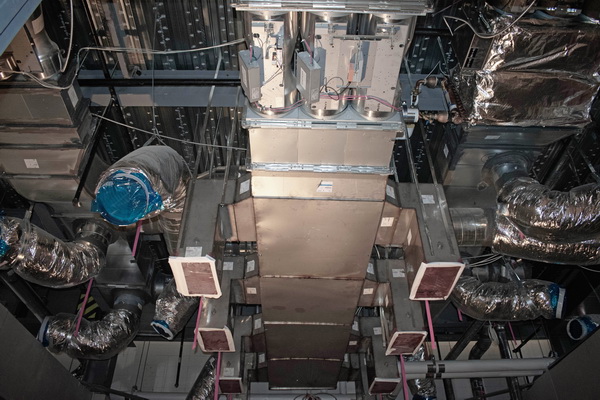
The duct system serving the fume hoods.
The Major Crimes and Property and Evidence Unit Building of the San Diego Sheriff’s Crime Lab is one of many laboratory projects on which Associate Mechanical Contractors (AMC) has worked, but this one stands out for its complexity including unique requirements and secure storage conditions.
The crime lab is one of 13 buildings on the county’s main operations campus. The five-story, 160,000 square-foot building houses 200 employees and includes 60,000 square feet of secure evidence and property storage, 54,000 square feet of office space and 44,000 square feet of state-of-the-art laboratory space.
The project included a central plant expansion for the additional requirements of the new crime lab. The basement, which is 25 feet high, contains sensitive evidence and delicate materials that require basement wall waterproofing and a permanent dewatering system.
.jpg)
Supply air ducts for the smoke removal system.
AMC president Rick Reinholz pointed out that the requirements for the crime lab’s air and exhaust systems were exacting. “Typically, if you're in a lab-type environment, you don't have the criminal element requirements on top of it. Just having the security measures for our systems – tamper-proof grills and man bars (for secure ductwork) and other things like protection of sensitive evidence. We're familiar with it, but you don't typically see all those elements mixed together.”
The laboratory exhaust and air handler systems were also used for the smoke evacuation system instead of completely separate air handling and duct systems. “On this project, the engineer designed that to be incorporated within the laboratory exhaust and the comfort cooling air handlers,” said Bruce Robuck, AMC operations manager.
“In the event of a smoke evacuation situation, the air handlers go into smoke evac mode, which shuts down a number of smoke/fire dampers and opens up other smoke/control dampers. The laboratory exhaust system also performs these functions. The engineer did it for space and also to maintain the laboratory conditions in a fire or smoke event,” Robuck explained.
The air handlers in the HVAC system are 100 percent redundant, which keeps occupants inside safe. “Once it's been determined that a carcinogenic or something has gotten loose in the exhaust system, the system switches over to the other air handling system. Those air handlers can continue to service the building while they decontaminate the other part of the building,” he noted.
The project included a mixed flow lab exhaust duct system ranging from ½-inch positive static pressure to 6-inch negative static pressure. The lab exhaust systems were made from welded stainless steel duct to avoid cross contamination of elements.
AMC also provided the mechanical systems for all 900,000 square feet of office space on the campus, which was certified LEED-Gold; the 160,000 square foot crime lab, also certified LEED-Gold; the 15,000 square conference center certified LEED-Platinum, and the 50,000 square-foot fleet facility.
The HVAC equipment AMC installed included:
- 168,000 pounds of galvanized duct and welded stainless steel duct systems.
- 950 registers/diffusers/grills.
- 146 variable air volume boxes and 92 Venturi air valves.
- 54 smoke/fire dampers and 24 low-leak isolation dampers.
- 18 laboratory fume hoods, 33 articulating snorkel arms, and three ventilated bio-safety cabinets.
- Four air handlers totaling 144,000 cubic feet per minute of air flow.
- Four laboratory exhaust fans totaling 104,000 cubic feet per minute of air flow.
- A shooting/gun range exhaust system and a heat and smoke removal system.
Robuck estimates that at the peak of the project AMC had 24 sheet metal workers on-site. The project took 11 months. “We do enjoy working with the county and they're extremely collaborative for a government agency. They take our input and analyze it correctly,” he said.
He credits his trained craftsmen for helping the project go smoothly. “I think it speaks well to our partners and their capabilities. Being union trained, our craftsmen are familiar with these complex systems as opposed to non-union workers. We're typically installing it faster and at a much higher quality,” he said.